Greg Jones
Asset Manager and Chief Geologist
Sino Gold Limited, Level 8, 17 Bridge Street, Sydney, NSW 2000
Key Words: gold, Carlin type, geology and geochemistry, resource estimate, China.
Located within the Golden Triangle region in southern China, Jinfeng is believed to be China’s largest undeveloped gold deposit. Sino Gold Limited has commenced bankable mine feasibility study on the deposit and is hoping to develop a 200,000oz/a operation. Drilling and underground development has successfully defined robust mineralization to a depth of over 500m below the surface and outlined a resource of 2.6Moz.
Mineralization is hosted within Triassic marine turbidites, including calcareous clastics, deposited on the southern margin of the Yangtze craton. The bulk of mineralization is primarily hosted by the composite F3 fault, a west-north-west striking, reverse structure cutting the turbidites at a high angle. Recent drilling has also intersected significant stratabound mineralization hosted by calcareous arenites within the footwall of the F3.
Sino Gold’s work has confirmed the continuity of mineralization and clearly indicated that the deposit exhibits many of the features that characterise the Carlin deposits of Nevada, USA including gold morphology (submicron within arsenical pyrite and pyrite), geochemical signature (elevated As, Hg, Sb, and Tl), alteration and general host lithologies (fine grained clastics, often calcareous). The overall depositional environment (depth of formation and temperature) and probable fluid chemistry (eg. pH, NaCl%) also mimics that generally accepted for these deposits and it is considered that the Jinfeng deposit represents a true Carlin analogy.
Sino Gold Limited (SGL) is a mid-tier gold company, recently listed on the ASX (SGX), focused exclusively on mining and exploration in China. The company was formed in 1996 and was the first foreign company to build and operate a mine in China. SGL currently operates the Jianchaling Gold Mine, Shaanxi Province, which produces approximately 80,000 ounces of gold per year and has recently commenced a bankable mine feasibility study on its Jinfeng gold deposit, Guizhou Province, PRC. The company is hoping to develop a 200,000 oz pa operation at Jinfeng, which would make it the largest gold mine in China
Recent SGL work has focused on testing the ore block continuity and metallurgical characteristics of the main sections of the ore body to about 500m below the surface. To date in excess of 15,000m of surface diamond drilling as well as underground development has been completed by the company, which has greatly increased the understanding of the geometry and controls on mineralization.
The Jinfeng gold deposit (also known as Lannigou) is located within the Qianxinan Prefecture, Guizhou Province, PRC, approximately 240km south west of the capital city of Guiyang (105°54 08 E, 25°06 48 N) (Figure 1), at a mean elevation of approximately 750m. The project area is lightly populated (mainly the Bouyei minority group) and has a subsistence farming economy.
Jinfeng forms part of a major mercury / arsenic / gold / thallium metallogenic system that dominates much of the province. Mining activity in the region has been ongoing from at least the latter part of the Qing Dynasty (+100 years), when mercury and arsenic mining of the central section of the main Jinfeng deposit was recorded.
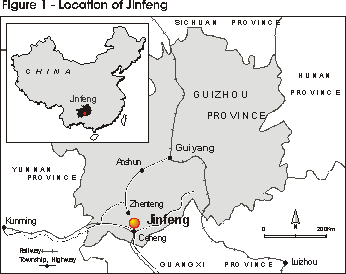 During the mid 1980’s renewed interest in gold resulted in the completion of large government sponsored stream-sediment geochemical programmes across China. This work resulted in the detection of 14 significant Au anomalies in the Jinfeng region and follow-up in 1984/85 defined 22 discrete prospects, one of which was the previously inspected arsenic occurrence on the main deposit at Jinfeng.
During the mid 1980’s renewed interest in gold resulted in the completion of large government sponsored stream-sediment geochemical programmes across China. This work resulted in the detection of 14 significant Au anomalies in the Jinfeng region and follow-up in 1984/85 defined 22 discrete prospects, one of which was the previously inspected arsenic occurrence on the main deposit at Jinfeng.
Intense exploration activity by the local exploration group under the BGMR (the 117 Geology Brigade) commenced and from 1986 to 1993 some 15km of diamond drilling and 8km of underground aditing were completed. This work successfully defined >50t of gold and in 1992 the deposit was listed by the Central Chinese Government under the 892 National Plan because of its likely impact to the economy.
Despite the deposits significance, exploration and development work was curtailed in 1993 due to a lack of funding and metallurgical challenges, and Jinfeng was offered to a number of large foreign gold companies. However, aside from a limited drilling programme in 1997, activity remained subdued, and it wasn’t until SGL commenced JV negotiations in late 1999 that interest in development was re-invigorated.
In April 2001, SGL signed a JV contract earning an 82% interest in the project for the staged payment of US$800,000 and a commitment to bring the deposit into production.
Jinfeng lies within the colloquially named Golden Triangle, a large (>100,000km2) gold rich region covering southwest Guizhou, southeast Yunnan and northwest Guangxi. In this area numerous gold deposits have been discovered (Figure 2), some with reported resources in excess of 1 million oz gold, including Zimudang, Jinya and the Huangchanggou (HCG) deposit, which lies at the heart of the Jinfeng property.
Gold mineralization is hosted within Cambrian to Triassic sediments deposited within the Youjian basin on the south-west margin of the Proterozoic Yangtze craton, formed following subsidence through crustal extension and rifting at the end of the Caledonian tectonic cycle (Qui, 2001). Thick sequences of carbonate through to siliclastic lithologies were deposited, evolving from the south-east to the north-west and stratigraphically upwards from marine to continental dominant assemblages. Importantly, this process resulted in the deposition of broad zones of transitional sedimentary facies, including impure carbonates and calcareous arenites, seen as critical host lithologies for gold mineralization in the region.
Later compressional tectonics during the Indosinian Yangshanian period (230-67Ma) resulted in the partial thrusting of the sedimentary sequences over the southern margin of the Yangtze craton and the generation of the complex structural fabric that characterizes the basin architecture, including the numerous domal structures, north-east thrusts and the brittle west-north-west and north-south striking faults that host a number of gold deposits in the region.
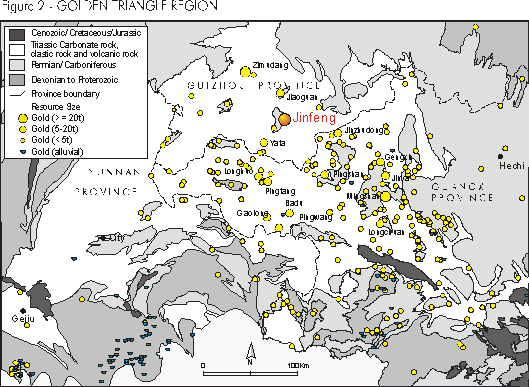
It was during this period that hydrothermal activity and gold deposition took place, possibly partially linked to thermal activity during the Yangshanian and basin dewatering in response to uplift and compression. Dating of the gold deposits is somewhat ambiguous, but is possibly similar to deposits within the Qinling region, to the north where gold deposition is believed to have occurred around 140Ma.
The Jinfeng project is located on the eastern margin of a large (25x12km) domal structure, the Laizhishan Anticline. Lithologies at the core of the dome are Carboniferous and Permian limestones (reef, bioclastic and massive), unconformably overlain by early to mid-Triassic turbidities, dominated by bedded, calcareous sandstones, siltstones, wackes, fossiliferous and carbonaceous shales and minor limestone units. The Triassic lithologies are interpreted to have formed within a continental slope margin, separating continental shelf sedimentation to the northwest from abyssal marine facies to the southeast.
Gold mineralization has been found within all lithologies, but the most significant deposits are developed within the turbidities, particularly within about 1km of the Permian contact where calcareous units appear to become more abundant. At least 3 significant zones of mineralization have been outlined within this corridor, the main deposit of Huangchanggou (HCG), Rongban and Lintan, with more recent work also defining strong gold anomalism on and or adjacent to the Permian / Triassic contact and within the Permian carbonates (Figure 3).
At HCG, gold mineralization is located at the junction of two faults, termed F2 and F3, which cut through one of the many open, north-west striking anticlinal structures developed within the project area (117, 1993). The bulk of mineralization is hosted within the composite west-north-west striking, steeply north-east dipping F3 fault, whilst the north-east striking, steeply south-east dipping F2 fault (Figure 4) offsets F3 and associated mineralized blocks to the north to form the Rongban prospect.
Within both faults, lithological units are intensely disrupted, with more competent arenites often forming broken and contorted blocks and lozenges within intensely strained, often partially milled shale and/or clay gouge. F3 has a dextral reverse movement sense of between 150-200m (117, 1993) and is up to 30m wide with generally sharp contacts with drag-folded host lithologies.
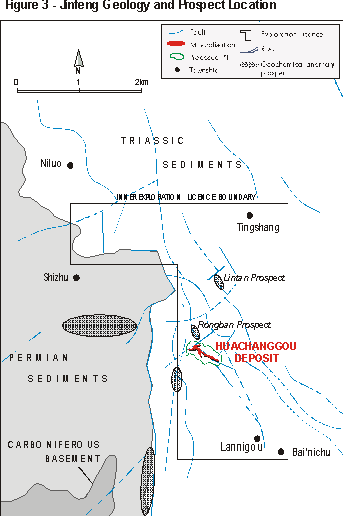 Within the deposit, the main zones of mineralization generally plunge steeply to the east in sympathy with the F3/F2 fault intersection and associated linking structures. Numerous footwall and hanging mineralized zones have been intersected in recent drilling, although the continuity of these zones is less well defined.
Within the deposit, the main zones of mineralization generally plunge steeply to the east in sympathy with the F3/F2 fault intersection and associated linking structures. Numerous footwall and hanging mineralized zones have been intersected in recent drilling, although the continuity of these zones is less well defined.
Ore grade mineralization consists of bifurcating, lenticular blocks with complex internal geology and rapid pinching and swelling dependent on host rocks and fault geometries / splay intersections. The deposit averages about 11m in width but, in a number of areas, mineralization exceeds +30m true thickness with a strong correlation between high grades and thicker blocks.
At least 5 significant high-grade zones of >8 gpt have been defined to date, with important controls on high-grade mineralization believed to include the intersection between F2 and F3 and linking structures, and the presence of coarser-grained calcareous arenites within or immediately adjacent to key fault structures.
Initial studies by SGL appear to show a clear spatial correlation between high-grade ore zones and a higher proportion of arenite host within mineralized blocks. Although also often calcareous, fine-grained shale and mudstone units are generally poorly mineralized and contain significantly less hydrothermal sulphides than the arenites, considered due to lower capacity of these lithologies for fluid-reaction induced porosity. In general, ore blocks hosted by finer-grained lithologies are thinner and lower-grade and are likely to have more complex geometries and grade distribution characteristics.
Of particular importance to the project has been the recent intersection of thick, high grade stratabound mineralization in deeper drilling in the immediate footwall of the F3 structure approximately 500m below the surface within the central section of the deposit. Intersections recorded in this drilling include 36m @ 7.9 gpt (HDDS00021) and 51m @ 7.4 gpt (HDDS00023) clearly defining what appears to be a substantial block of ore projecting away from F3 within one of the thicker, more calcareous units (Figure 5).
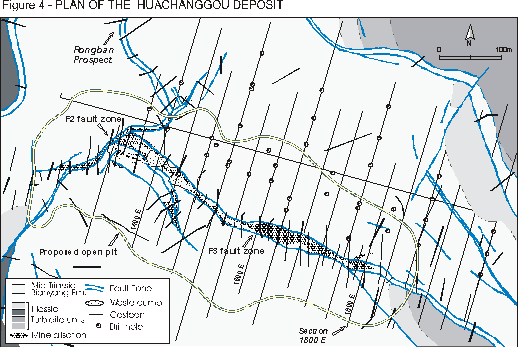
Gold mineralization consists of finely disseminated sulphides within a quartz+_ carbonate (dolomite/ankerite?) matrix. There is a moderately strong correlation between percentage sulphides and gold grades, with the gold believed to form very fine, submicron (<0.2 micron) sized particles within the lattice of arsenical pyrite (commonly arsenical rims to pyrite cores) and pyrite, and to a much lesser degree within fine arsenopyrite crystals (Peters et al, 2002b).
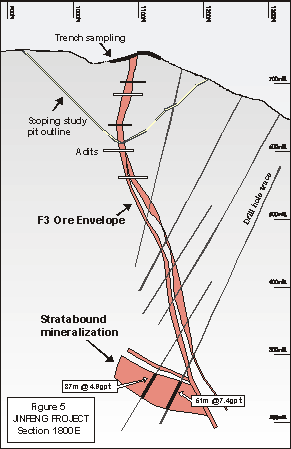 Mineralized zones are often overprinted by coarsely disseminated, stockwork and crackle-veined orpiment, realgar, cinnabar and stibnite. Whilst these late stage minerals are generally not gold bearing, they are often spatially related to high-grade ore blocks and appear to define zones of long-lived extension and fluid ingress into the more competent, brittle parts of the deposit. They are believed to have been deposited during the waning stages of the same hydrothermal event that generated the gold mineralization (Leach, 2003).
Mineralized zones are often overprinted by coarsely disseminated, stockwork and crackle-veined orpiment, realgar, cinnabar and stibnite. Whilst these late stage minerals are generally not gold bearing, they are often spatially related to high-grade ore blocks and appear to define zones of long-lived extension and fluid ingress into the more competent, brittle parts of the deposit. They are believed to have been deposited during the waning stages of the same hydrothermal event that generated the gold mineralization (Leach, 2003).
Alteration assemblages include silicification, dolomitization, argillization, carbonation as well as the sulphidation associated with mineralization. All assemblages are interpreted to be associated with a single hydrothermal event. More intense, pervasive silicification is generally associated with the coarser arenites and is generally spatially related to the proximity of feeder structures.
Silicification and the bulk of gold deposition is interpreted to have been contemporaneous with the dissolution, by moderately acidic fluids, of the carbonate matrix within calcareous arenites (and associated increase in rock porosity) and the partial replacement of calcite by dolomite. In general, the interstitial matrix of all mineralized material, including less intensely altered and lower-grade blocks has been completely stripped of calcite, unlike the distal, stratigraphically equivalent, non-mineralized lithologies.
Precipitation of auriferous sulphides is believed to been enhanced by iron minerals relict within the sediments post-carbonate dissolution (Leach, 2003).
Like most of the other gold deposits within the region, HCG is highly anomalous in As (av. 0.5%), Hg (av. 116ppm), Sb (av. 113ppm), Tl and, to a lesser degree, Cu and Zn. From available data, zones of very high As and Hg are evident, particularly towards the western boundary of the deposit near the F2/F3 intersection where significant orpiment, realgar, cinnabar and liquid mercury are recorded. Interestingly, the highest average Hg (430ppm) and S (2.1%) levels are recorded in the thick stratabound blocks at the base of the resource envelope, where it appears likely that the host rocks were more porous (ie. a higher original proportion of interstitial calcite), allowing continuous fluid influx through to the end of the hydrothermal cycle.
The first reliable resource estimates for HCG were completed by the 117 Brigade in 1993. Subsequent resource estimates were completed by SGL in 2000 and in early 2003 following the digitization and reinterpretation of the huge volume of Chinese data. In August 2003 (Table 1) a further estimate was completed by SGL, following the successful completion of the diamond drilling campaign. Strong resource growth is evident, driven by the recent intersection of the unexpectedly thick zones of mineralization within and at the base of the previous resource envelope.
Date
|
Tonnes
|
Grade (gpt Au)
|
Ounces (M oz)
|
|
Jan. 2000
|
6.9
|
6.9
|
1.5
|
|
Jan. 2003
|
9.1
|
6.1
|
1.8
|
|
Aug. 2003
|
14.1
|
5.8
|
2.6
|
This has in turn resulted in an improvement in the already high ounces and tonnages per vertical meter (Figure 6), particularly below the about the 600m RL where the effects of erosion are less evident and where the average ounces per vertical meter exceed 5,000 oz/vm.
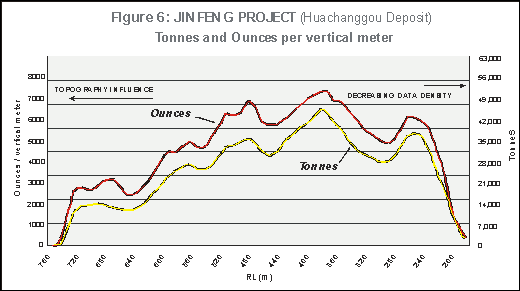
The resource is considered robust, with good sampling characteristics and relatively good continuity, particularly in the thicker, higher-grade areas. Internal ore zone heterogeneity is apparent, but is unlikely to be a major issue in an operation. Sampling statistics are particularly good, with a low nugget and, for a gold deposit, very low coefficient of variation (CV 0.8). Assay repeatability is excellent and, provided sampling and assay quality is maintained, gold assays taken from the deposit should be relatively reasonable local estimators of an ore zone’s gold grade.
Much has been written about the deposits of the Golden Triangle and their affinities (and differences) to the Carlin deposits of Nevada. Chinese academics and their American colleagues have long recognized that the deposits in general share many distinct characteristics to Carlin and, in a direct sense, represent the Chinese analogy of this important class of mineralization. Recent papers by the USGS (Peters et al, 2002a and b), Zhang et al (in press) and Li, 1996 amongst other provide clear comparative evidence and reasoning for this association.
Recent work by SGL at Jinfeng has not only strongly reinforced this concept and confirmed the key characteristics for Jinfeng, but also significantly added to the exploration appeal of the area. It is clear that gold deposition at Jinfeng occurred within similar host lithologies, under similar PT conditions and with a similar fluid chemistry to the Carlin deposits. Importantly, the key deposition mechanisms, including the dissolution of carbonate matrix and the precipitation of disseminated mineralization within the reactive calcareous arenites, penetrating away from cross cutting structures, were in evidence.
A comparison of the principal characteristics between Jinfeng and the general Carlin deposits are detailed in Table 2. The primary similarities can be summarized as follows
1. Host lithologies paleo-continental margin setting – transitional calcareous siliclastics and silty limestones, carbonaceous shales and mudstones.
2. Styles of mineralization disseminated early sulphides within both structurally controlled and stratabound blocks.
3. Auriferous sulphides arsenical pyrite, pyrite and arsenopyrite (in order of relative percentage). Also presence of orpiment, realgar, cinnabar and stibnite as late veins.
4. Elemental association Highly elevated As, Hg, Sb, Tl, Ba. High Au/Ag ratios.
5. General fluid chemistry moderately acidic, 5-6% NaCl, bisulphide gold complexes.
6. Gold habit submicron particles within sulphide lattice.
7. Alteration silicification, argillization, decalcification, carbonation.
8. Gross isotopic signatures similar S0/0034 and O0/0018(SMOW).
Key differences include the lack of intrusives at Jinfeng (even at depth where regional magnetics and gravity data are relatively subdued), the likely higher temperature of formation (>=2500) and lack of epithermal mineralization, and possible fluid sources (possible metamorphic input at Carlin verses meteoric for Jinfeng).
Conclusion
The Golden Triangle region of China represents one of the worlds. great remaining underexplored gold regions. Recognized for it’s gold potential relatively late in the latest gold cycle and suffering from a lack of exploration funding or application of modern exploration techniques over the last decade, the region presents one of the few remaining genuine opportunities to discover significant gold deposits within a relatively low risk environment. The region has the potential to become one of China’s most important gold producing areas.
SGL’s Jinfeng project has the demonstrated potential to become a very significant gold deposit, justifying a major new operation and investment into China. Recent drilling and geological work on the deposit has confirmed strong analogies to the Carlin deposits of the USA and greatly enhanced the exploration appeal of the deposit and region.
ACKNOWLEDGEMENTS
This paper could not have been written without the hard work and ideas of the many Sino Gold geologists who have worked on the project over the last 4 years. Special mention needs to be given to Brian Williams, Chris Cairns, John Zhang, Yumin Qui and Steve Boda, as well as the team at Jinfeng who have toiled under sometimes difficult conditions to generate the picture of the deposit as we understand it today.
References
Leach, T., 2003, Comments on the Alteration and Mineralization in the Lannigou and Jianchaling gold deposits, China. Internal Sino Gold Limited report. TLC report number : 03012.
Li, Z., 1998, Comparative Geology and Geochemistry of Sedimentary-Rock hosted (Carlin-type) Gold deposits in the People’s Republic of China and in Nevada, USA: USGS open file report 98-466.
Peters, S.G. Jiazhan, H., Zhiping, L,. Chenggui, J., 2002a. Introduction to and classification of sedimentary rock hosted Au deposits in P.R. China. USGS open file report: 02-131. pp 1-60.
Peters, S.G., Zhiping, L., Chenggui, J., 2002b. Geology and Geochemistry of sedimentary rock hosted Au deposits of the Qinling Fold Belt (Chuan Shan Gan) Area, Shaanxi, Sichuan and Gansu Provinces, P.R. China. USGS open file report 02-131. pp 167-254.
Qiu, Y., 2000. Report on review of Geology and Mineral Resources of the Guizhou Province, P.R. China. Internal Sino Gold Limited report. 39 pages.
Zhang, X, Spiro, B., Halls, C., Stanley, C.J., and Yang, K., 2003. Sediment-hosted disseminated gold deposits in southwest Guizhou, PRC: their geological setting and origin in relation to mineralogical, fluid inclusion and stable-isotope characteristics. International Geology Reviews, Vol. 45, (in press).
|
|
JINFENG
|
CARLIN
|
Age |
<140 Ma
|
Mid Tertiary (≈40Ma)
|
Key Host Lithologies |
Sandstones / siltstones / mudstones, calcareous transitional lithologies
|
As for Jinfeng with intrusives
|
Intrusive Relationships |
No significant intrusives
Small lamprophyres
|
Calc-alkaline magmatism
|
Styles of Mineralization |
Thin oxide blanket high angle fault bound & stratabound blocks
|
Similar to Jinfeng
Discordant & stratabound
Significant hypogene oxide
|
|
Tectonic Framework
|
Edge of craton margin extension and rifting during subduction
|
Back-arc rifting and magmatism deep crustal fault control
|
|
Fluid Chemistry
|
Up to 5.6% NaCl
Up to 0.17% Co2
Moderately acidic (pH 5-6?)
|
<6% NaCl
<4 mole CO2
pH 5 – 6
|
|
Au Transport Mechanism
|
Bisulphide?
|
Bisulphide
|
|
Temperature of Formation
|
≈ 250° C
|
150° – 250° C
|
|
Depth of Formation
|
1.5 – 2.5km
|
2 – 5 km
|
|
Associated Elements
|
High As, Hg, Sb, TI,
Elevated Cu, Mo, Ba
High Au / Ag ratios
|
As, Hg, Sb, TI, Ba
High Au / Ag ratios
|
|
Fluid Type
|
Meteoric
|
Meteoric / Metamorphic(?)
|
|
Gold Habit and key auriferous sulphides
|
Sub-micron within pyrite, arsenical pyrite, arsenopyrite
|
As for Jinfeng
|
|
Alteration
|
Silicification, dolomitization, argillization, decalcification, carbonization
|
As for Jinfeng
|
|
Gangue Mineralogy
|
Quartz, carbonate, clays, Orpiment / realgar / cinnabar/ stibnite + carbon
|
As for Jinfeng
|
|
Deposit Size
|
Likely > 3 Moz
|
All ranges and > 5 Moz
|
|
Grade |
6.0 gpt Au
|
1 to 15 gpt
|
|
Isotopes S0/0034
|
8 – 13 per mil
|
0 – 20 per mil
|
|
O0/0018 (SMOW)
|
18 per mil
|
1 – 18 per mil
|